
2cm Flak 38
Trumpeter 1:35 Scale Kit No. 02309
Kit review by Terry Ashley
Technical Advice by Jon Bailey

The Gunner fired the weapon by way of two foot pedals; each pedal fired the two diametrically opposite guns allowing the other two guns to be reloaded for continuous firing. It could also be fired in automatic or semi-automatic mode and all four guns could be fired at the same time by depressing both firing pedals.
The mount was fitted to a triangular base and was normally transported on an Sd.Ah.52 trailer as well as fitted to vehicles such as the Sd.Kfz.7/1 half-track and Panzer IV based Wirbelwind plus some one off installations.
As well as Army use, the Flakvierling 38 was also used by the Kriegsmarine fitted to U-boats and ships as well as on trains and fixed installations such as around harbours and on flak towers.
The kit gives you the full Flakvierling mounting on the triangular base as well as a Sd.Ah.52 trailer plus a few magazine boxes and 20 round magazines with the ability to build the kit in firing or travel configuration.
The kit consists of 117 parts in light grey plastic and further 60 etched parts along with a decal and instruction sheet.

Unfortunately Trumpeter chose to base this kit on the now 35 year old Tamiya Flakvierling kit which had some substantial dimensional issues and these have been replicated in this kit along with more issues with the additional parts added by Trumpeter to produce a kit that is fundamentally flawed dimensionally if that is an issue for modellers.
These dimensionally issues are confirmed when comparing the kit with the available 1:35 plans in the books listed below; these are mostly showing the Flakvierling on mobile mounts such as the Wirbelwind and Sd.Kfz.7/1 so not all the features are measurable, such as the triangular base. Even taking into account some minor differences between the plans themselves the issues still remain.
The most substantial issue being the main upper carriage is too short by 4mm meaning the whole mounting is “squashed” and this filters though to other parts such as the gun cradles, the recuperator housing and spent shell collector box which are all undersized. The 2cm gun dimensions are all over the place as are a number of smaller items that we’ll get to during the review.
Standard of moulding is best described as adequate as there are few pin marks visible after assembly but a fair bit of fine flash about the place as well as some moulding being on the heavy side. There are also the heavy mould seam lines and the many plastic nodes being the only cleanup needed on the parts. There are some quite small and fine parts that need the usual care in cleanup and assembly as well as the larger etched parts that really need to be soldered and some skills here will be advisable.
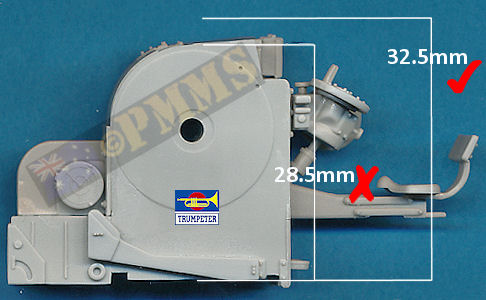
At the front is a three part recuperator housing with the circular ribbing moulded on and the join seam between the two recuperator halves (parts L19, L20) will need some filler with the assembled recuperator housing fitting to the front of the carriage. The recuperator housing and spent shell collector box as mentioned are both too short in height as a consequence of the height issue.
The large locking lever (part L29) fits into the holes in the sides of the spent shell collector box but it’s also too short as a consequence of the Carriage height issues as well as being too wide. It should sit between the two Gun Cradles when fitted but not only does it not do that but actually fouls on the curved gun shields, in short it just doesn’t fit at all.
There is another problem here in that there is only one locating hole on either side of the collector box for either the locking lever or the front armoured box shield, but not both as there should be. You will have to drill two more locating holes about 2mm in front of the existing holes for the locking lever as well as reducing the width of the lever so it misses the shields, oh what a web we weave etc. etc.
Best to cut off the locating pin on the inside of the box arm but you will also need to thin the box sides to fit over the lever as the box parts are quite thick, they also have the wrong profile with the sides being too wide and lack the inward kink on the attachment arm which is designed on the real thing to allow the box arms to fit around the locking lever.
At the back of the carriage is the gunner’s position with separate firing pedals added to the foot plate, this gives better definition to the pedals.

The seat support and traverse gear drive shaft are in one piece with the gunner’s seat and backrest also as separate parts, the drive shaft ends fit into the foot plate and underside of the traverse gear housing without any problems.
The traverse gear housing is in two parts with the two small thumb knobs included along with separate traverse hand wheels with the assembled gear housing attached to its mounting plate which in turn is attached to the upper carriage while aligning with the top of the traverse gear drive shaft.
The top Gunner’s shield is in three main etched parts that requires careful soldering but the shield door is in two halves when it should be a single door flap while the shield itself appears to be a little on the tall side?
The main sight support arm is in one piece with fairly soft details and added to this is the smaller L shaped sight arm which unfortunately has a notch with the upper section twice the thickness on the lower section that fits to the supporting arm and this notch fouls the support arm and will not allow the guns to depress past the 45° mark.

This means you can only depict the guns elevated above 45° unless you modify the upper sight arm to be the same thickness for the full length of the arm, you will have to add back the attachment pin for the connecting rod if you modify the arm.
The sight arm is attached to the upper carriage recess next to the battery box with the stop handle in two parts that have to be carefully butt joined to not leave any ‘step’ at the join (parts L23, L24).
Added to the bracket arm is the gun sight (part L4) with etched sight ring, unfortunately the sight provided in the kit doesn’t represent any known Flakvierling 38 sight I have seen in any references or photos. Early versions of the Flakvierling 38 had the Flakvisier 40 sight (also used on the FlaK 38) with distinctive square sight housing; later versions had the Linealvisier 21 or the revised Schwebekreisvisier 30/38 sight.
As mentioned the sight provided doesn’t represent any of these apart from the ring sight itself and one option is to replace the kit sight with the etched Schwebekreisvisier 30/38 sight from the Lion Roar Flakvierling 38 update set #LAS35008 . This also is not perfect missing the eye guard and being a little oversized but does give a better representation of the sight than the kit sight does.

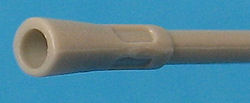
Overall 2cm FlaK gun

The textured hand grips included on the tubes are represented with engraved lines only and its best to fill these for a better appearance if you are going to stick with the kit guns?
The guns have the magazine bracket included with the receiver and you can add the separate magazines for guns in action but you will need to trim off the raised rib on the back of the magazine that fits into the bracket for them to fit.
The circular Gun Cradles are slightly undersized due to the Carriage issues mentioned above with the moulded on detail fairly basic and softish, the Cradles have the gun sleighs moulded on which results in a square hole under the sleigh gun attachment bracket but this is mostly hidden when the guns are attached.
There are engraved elevation quadrants around the curved lower cable drum bracket but this should only be on the left side so shave these off from the right side bracket. The three rectangular holes are not opened out as they should be, and hollowing these out will improve the appearance.
Details missing from the Cradles are the two fine firing levers on the back edge of both Cradles and two small deflecting pullies on the rear edge of the left side cradle are also missing, but it should be fairly easy to add these with plastic card discs.
The Cradle shields are in 5 etched parts each and due to the openings for the guns it is very difficult to bend the shields as they want to bend more at the thinner sections around the holes and extreme care is needed with these. The four smaller inner brackets also need to bent to shape but there is no indication given for the correct amount of curve in the shields and you just have to play it by eye matching the shields to the curve of the Gun Cradle.
Added to that is the small inside brackets first have to be bent at right angles and as the metal is about .05mm thick and very narrow it’s virtually impossible to bend these as they have a curve as well. Ever tried putting a curve in L shaped metal along its longitudinal edge? Not easy at the best of times and with such thin strips, well good luck. So I hope you will forgive me for not including the full shields in the build images, life is too short.
Adding the guns to the Cradle is a hit and miss affair as there are no actual locating pins or guides and you must instead just line the guns up with the sleigh attachment brackets ensuring all are in the same position. There is a locating pin on the inside of the gun receiver but no hole to put it in so just glue this against the Cradle face.
When fitting the gun Cradles to the Upper Carriage there are notched pins on the inside of each Cradle that fit together inside the Carriage so make sure both Cradles are aligned correctly.
After attaching the Gun Cradles to the Upper Carriage the left side Cradle is attached to the sight arm by way of the connecting rod (part L21) but this along with the sight arm are not designed to move. Therefore you have to decide on the gun elevation required as you glue the connecting rod in place as mentioned above along with gluing the sight arm in place.
If you wanted to have the guns elevate the pivot points for the sight arm and connecting rod would need to be altered with pins added to allow movement but then you have the 45° elevation issue as per above.
Before going to the trouble of making the gun elevate there is another issue resulting from the “squashed” Carriage in that the right side Gun Cradle fouls on the stop handle (parts L23, L24) so you can’t move the gun below 45° elevation in any case.
The large shields are entirely in etched metal with 5 parts per shield side and these do require careful assembly and soldering is the best option as some of the joins are plain butt joins and cyanoacrylate (super glue) simply won’t hold in these instances. There are two large notches that mark the mid shield bend line and these will have to be filled with solder as they are rather unsightly if left unattended.
Detail on the shields sees the rivets are raised embossing on the inner and outer shield faces but there are no latches or other details provided, also there are two inner stiffening ribs provided but there should only be one rib on the actual shields so just leave off the inner rib (parts PE-D19, PE-D20).
Attaching the inner mounting fillet (parts PE-C3, PE-C6) is not for inexperienced modeller as there are no precise locating points provided and you also need to attach these at about 70 degrees to the main shields which is not that clear in the instructions. Added to the fillet is a plastic mounting rod for fitting to the lower Platform but the mounting fillet is the wrong shape and too wide as well as the mounting rod being too long.
But once you have got that far the top folding shield flap is missing altogether and you are left with a large gap when the shields are fitted in place, this can be made from plastic card as it’s just a flat plate if you wish?
Is your head hurting yet, mine is? (Sorry)
The magazine racks are entirely in etched brass but lack the square wood pads on the bottom and rear plates for supporting the magazines. The back and lower plates have slots to take the etched triangular segments but the slots are way wider than the segment thickness so you have to be very careful these are all perfectly vertical when fitted. It’s best to solder these segments due to the vague fit as this will fill the gaps at the same time, you can file the back of the plates smooth after soldering for a better appearance.
The rectangular box and bent rod tubes on rear of the magazine racks have very poor detail definition while the two foot rest posts at the front are too long but could easily be cut down in size.
The two Loader’s seats have separate back rests and the mounting posts have the lower U bracket for fitting to the separate small etched mounting bracket (part PE-D24), this mounting bracket has to have the edges bent and then glued to the outer walk board section allowing the seats to be positioned in the raised firing or folded travel modes. These etched brackets extend out past the plastic boards which look rather unsightly when the outer board sections are in the travel position.
Fitting of the Upper Carriage to the Platform is by way of the notches and lugs in the corresponding assemblies allowing the gun mounting to rotate.
There are also numerous small etched parts added for the bolt heads on the Base ‘legs’ and the levelling shaft housings to finish off the Base. The circular central turntable has the securing notch bracket that fits into the corresponding cut-out in the base of the Platform allowing the gun mounting to rotate freely.
The large trailer chassis has the U shaped section and front A frame in one piece but doesn’t have the forward stand if not being towed. Detail on the frame is very basic with just the front air tank and side regulator plus the front handles all moulded with the frame plus a separate hitching hook on the underside of the A frame but the step plate above the regulator is missing (it’s on the Tamiya trailer though).
The two winch assemblies at the end of each frame arm are made up of just three parts each with totally inaccurate hooks for attaching the gun platform to the trailer with the winch assemblies also being very basic in detail.
The one piece fenders are attached to the frame with additional small etched parts for the mounting brackets and while the fender storage boxes are included the locating holes in the fenders are not opened out. As these boxes were not always fitted to the trailer this is actually good and if you wanted to fit the boxes just open up the holes.
The wheels/tyres have good detail on the tyre tread and rim/hub detail and these have the rear axle stubs trapped inside the wheel as well as the separate rear tyre sidewall section allowing the wheels to rotate freely.
Overall this is a very basic rendition of the Sd.Ah.52 trailer that lacks detail but I guess it fits with the level of detail on the rest of the kit. If you want a proper Sd.Ah.52 trailer run way quickly without looking back and grab the new Bronco Sd.Ah.52 trailer kit.
Included are two full colour illustrations of the gun and trailer in overall German Gray and Dark Yellow with no other markings provided as well as the various paint colours used given for Humbrol, Model Master, Mr.Hobby, Tamiya and Vallejo,
Option 1:
Overall Dark Yellow.
 Option 2: Overall German Gray  |
The work needed on the etched shields seems out of proportion the level of detail in the remainder of the kit with the shields themselves not without their problems and replacing the plastic barrels with metal barrels will greatly improve the appearance.
Sorry but there is little to recommend with this kit if accuracy is of any concern as it really is a mess and apart from being relatively cheap to buy doesn’t have much else going for it especially with the other Flakvierling kits available.
Rating: Flakvierling 38: 6.0/10
Flakvierling 38 with Trailer: 6.5/10
A more detailed look at this kit compared to the others available will follow shortly as a full 5 way kit comparison of the AFV Club, Bronco, DML, Tamiya and Trumpeter Flakvierling kits.
Click on thumbnails for larger view





Detail and assembly images




 2cm
FlaK38
2cm
FlaK38Muzzle Reference images
| TM-E9-228 2cm Flakvierling 38 Four barrelled mount Easy 1 Productions  |
2 cm Flakvierling 38 Nuts & Bolts Vol.27  |
Flakpanzer IV Wirbelwind (Sd.Kdz. 161/4), Ostwind & Kugelblitz Nuts & Bolts Vol.25  |
| Flakpanzerkampfwagen IV and other Flakpanzer projects from 1942 to 1945 Panzer Tracks No.12-1  |
German
20mm FlaK in WWII 1395-1945 Schiffer Military History ISBN: 0-88740-758-7 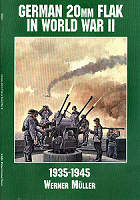 |
Sd.Kfz.7 in detail Special Museum Line No.36 Wings & Wheels Publications ISBN 80-86416-60-7  |
| Halbketten Zugkraftwagen 8t Sd.Kfz.7/1/2 AFV Super Detail Photo Vol.9 Published by Model Art Co.Ltd. 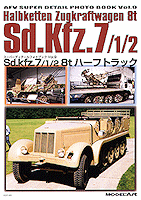 |
Flak
at War Trojca Publications Waldemar Trojca, Karlheinz Münch ISBN: 83-60041-15-6 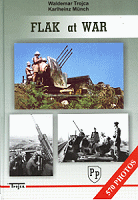 |
German Anti-Aircraft Combat Vehicles Revised Edition Ground Power Special Feb '08  |
Thanks to my credit card and
 for
the review kit.
for
the review kit. 
